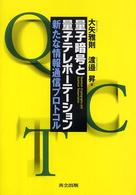- ホーム
- > 洋書
- > 英文書
- > Politics / International Relations
基本説明
New in paperback. Hardcover was published in 2011. This book deals with spatial policy issues in both South and North Korea. The book also examines whether if reunification occurs, the capital should remain in Seoul or be relocated.
Full Description
The potential for reunification of the two Koreas, whether in the short or long term, argues for a comprehensive look at policy and planning issues that encompass the peninsula as a whole. This book deals with spatial policy issues in both South and North Korea in a broad and non-political way.Part one deals with South Korea, examining cultural changes, the capital city of Seoul, Greenbelt policy, the balanced national (regional) development strategy, and the new mega-regional approach. Part two delves into aspects of development in North Korea, such as the limitations of national statistics, the marketization of the economy, integration with the rest of North East Asia, and the need for a spatial infrastructure strategy. Part three examines the case for reunification in the interests of both the South and North. It argues that a transitional approach would be less costly and less risky than sudden reunification primarily via an early strategy of shifting more capital to the North and later by moderating migration flows to the South. The book also examines whether the capital should remain in Seoul or be relocated elsewhere should reunification occur.
Professors, students and public policy officials in the fields of Asian studies, regional economics and planning, urban studies and political science and any reader interested in the future of Korea will find this book very current and enlightening.
Contents
Contents:
Preface
PART I: ISSUES AND TRENDS
1. Introduction
Chang-Hee Christine Bae and Harry W. Richardson
2. Re-inventing Korea
Eric J. Heikkila
3. Demography and Urbanization
Chang-Hee Christine Bae and Harry W. Richardson
4. Urban Issues in the Capital Region and South Korea
Myung-Jin Jun
5. Seoul
Harry W. Richardson and Chang-Hee Christine Bae
6. Quality of Life and Liveable Cities
Chang-Hee Christine Bae and Harry W. Richardson
PART II: REGIONAL POLICIES IN SOUTH KOREA
7. Greenbelt Policy
Chang-Hee Christine Bae, Myung-Jin Jun and Harry W. Richardson
8. Balanced National Development
Harry W. Richardson
9. PCRD (Presidential Commission on Regional Development) and the New Regional Policy
Harry W. Richardson
PART III: NORTH KOREA
10. DPRK Statistics: Availability and Reliability
Suk Lee
11. The Role of Markets in North Korea
Curtis Melvin
12. Lifting the North Korean Economy
Won Bae Kim
13. A Global Business Strategy for North Korea
Harry W. Richardson and Chang-Hee Christine Bae
PART IV: REUNIFICATION
14. Economic Integration Strategies for Korean Reunification: Lessons from Recent History
Jiyoung Park
15. A Spatial Strategy for Korean Reunification
Won Bae Kim and Harry W. Richardson
16. Options for the Capital of a Reunified Korea
Harry W. Richardson and Chang-Hee Christine Bae
References
Index








